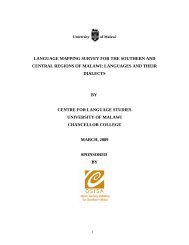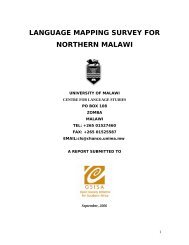SOCIOLOLINGUISTIC SURVEYS - Centre for Language Studies
SOCIOLOLINGUISTIC SURVEYS - Centre for Language Studies
SOCIOLOLINGUISTIC SURVEYS - Centre for Language Studies
Create successful ePaper yourself
Turn your PDF publications into a flip-book with our unique Google optimized e-Paper software.
5.5.4.1 SUMMARY<br />
Although this category had left the school system or had never been part of it in any<br />
direct manner, it is still important that in general terms it supports the earlier findings<br />
among the teachers. For instance, many respondents in this category do not find it<br />
embarrassing to speak Chilomwe, neither do they find it embarrassing to identify<br />
themselves as Lomwes. These respondents have also indicated their wilingness <strong>for</strong><br />
Chilomwe to be used in schools. The responses from the group also indicate that<br />
English, in general, causes problems <strong>for</strong> learners in schools while Chichewa does not.<br />
5.6 CONCLUSIONS<br />
There are a number of conclusions which can be drawn from the data presented above:<br />
1) That the majority of Lomwes have a positive attitude towards their ethnic group and<br />
their language, which contradicts the pervasive myths that the Lomwes do not have<br />
pride in their language and culture;<br />
2) That the majority of pupils (67.5%) in Chilomwe speaking areas would like to be<br />
taught in Chilomwe;<br />
3) That the majority of their parents/guardians (77.5%) support the idea of having their<br />
wards taught in Chilomwe;<br />
4) That a samll majority of teachers (41.4%) would accept Chilomwe in the schools;<br />
5) That Chichewa has permeated every fabric of Lomwe soceity thereby making Lomwe<br />
societies bilingual/multlingual.<br />
The implications following from the above conclusions are that; first, were Chilomwe to<br />
be introduced as a medium of instruction in the said areas, it would be accepted by the<br />
majority of the people. This entails that the MOE should start thinking of training<br />
teachers and preparing materials in this language. However, be<strong>for</strong>e that exercise is<br />
undertaken, the MOE should examine the possibility of using the Chimihavani variety as<br />
the “standard” and devising a standard orthography based on it.<br />
87





